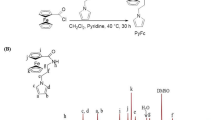Abstract
Reflection of microwave radiations from single layer and two-layer materials is calculated. Microwave absorbing materials are formulated by mixing a commercially available paint or rubber with the conducting polypyrrole (PPy) powder. The reflection loss strongly depends on thickness and complex permittivity of the material. For a single layer material, optimum values of the real part, ɛ′, and imaginary part, ɛ′′, of the complex permittivity are found by calculations which lead to a minimum reflectivity at a given sample thickness. The ability to readily tailor the conductivity of the PPy powder enables the design of microwave absorbers according to theoretical desired values of ɛ′ and ɛ′′. A paint panel containing 2 wt% of PPy powder with a thickness of 2.5 mm exhibits a reflectivity < − 10 dB (i.e. at least 90% absorption of the incident radiation) over 12 to 18 GHz. Blending and milling during the manufacturing process can destroy the original fibrous shape of PPy aggregates leading to low radiation absorption. In an attempt to achieve a broadband absorber, a two-layer system consisting of a first layer containing PPy powder and a second layer containing carbonyl iron has been fabricated.
Similar content being viewed by others
References
A. Feldblum, Y. W. Park, A. J. Heeger, A. G. Macdiarmid, G. Wnek, F. Karasz and J. C. W. Chien, J. Polym. Sci.: Polym. Phys. Ed. 19 (1981) 173.
P. T. C. Wong, B. Chambers, A. P. Anderson and P. V. Wright, Electronics Lett. 28 (1992) 1651.
L. Olmedo, P. Hourquebie and F. Jousse, Adv. Mater. 5 (1993) 373.
P. Hourquebie and L. Olmedo, Synth. Met. 65 (1994) 19.
V.-T. Truong, DSTO Aeronautical and Maritime Research Laboratory, Internal Report, 1997.
A. Amiet, Defence Science and Technology Organisation, private communication.
P. G. Lederer, “An Introduction to Radar Absorbent Materials” (Royal Signals and Radar Establishment, Malvern, UK), Report No. 85016, 1986.
Y. X. Gan, F. H. Wang and C. Q. Chen, Composites 23 (1992) 435.
E. F. Knott, IEEE Trans. Antennas Propag. AP-27 (1979) 698.
D. M. Bigg, in “Metal-Filled Polymers” edited by S. K. Bhattacharya (Marcel Dekker, New York, NY, 1986) p. 165.
C. Cametti, A. Furlani, G. Iucci and M. V. Russo, Synth. Met. 51 (1992) 45.
A. Lian, S. Besner and L. H. Dao, Synth. Met. 74 (1995) 21.
V.-T. Truong, unpublished results.
M. B. Amin and J. R. James, The Radio and Electronic Engineering 51 (1981) 209.
K. C. Pitman, M. W. Lindley, D. Simkin and J. F. Cooper, IEE Proc.-F, 138 (1991) 223.
R. Ueno, N. Ogasawara and T. Inui, in “Ferrites: Proceedings of the International Conference” edited by H. Watanabe, S. Iida and M. Sugimoto (Japan, 1980) p. 890.
Author information
Authors and Affiliations
Rights and permissions
About this article
Cite this article
Truong, VT., Riddell, S.Z. & Muscat, R.F. Polypyrrole Based Microwave Absorbers. Journal of Materials Science 33, 4971–4976 (1998). https://doi.org/10.1023/A:1004498705776
Issue Date:
DOI: https://doi.org/10.1023/A:1004498705776




